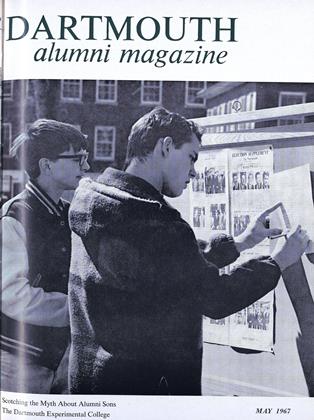By RobertE. Pike '25. New York: W. W. Norton &Co., Inc., 1967. 288 pp. $6.95. Illus.
Bob Pike, versatile chairman of the Foreign Language Department at Monmouth College, New Jersey, now takes his place as heir apparent to the late Stewart Holbrook, recognized Boswell of the Yankee lumberjack.
Although neither author limited his writing to loggers of the Connecticut River headwaters, it is obvious they describe best the valley from Lancaster north to Pittsburg, where both spent their most impressionistic younger years.
Pike's current contribution to the lore of the logging woods and driving streams includes many references of Dartmouth interest. Quite properly, he reports, "International Paper Co. owes much of its preeminence to the recently retired chairman of its board of directors, John H. Hinman ('08), an old logger from North Stratford, who got his start on the Nulhegan scrimmaging with George Van Dyke, a man-size antagonist."
Dorothy Hall Leavitt of Norwich, wife and daughter of well-known alumni, contributes one of many anecdotes describing the unpredictable nature of George Van Dyke. No record of exploits in the tall timber could be complete without including the redoubtable Tom Blandin, father of Amos B. Blandin Jr. '18.
The author gives credit to two other Dartmouth alumni who have researched chapters of this same history: C. Francis Belcher '38, authority on logging railroads of the White Mountains, and J. Willcox Brown '37, author of The Forest History of MountMoosilauke.
Landmarks familiar to most Dartmouth readers localize the account. "The old covered Ledyard bridge at Hanover, beloved by so many students, sturdily withstood all the attacks of the rivermen, though many great jams piled up behind it." Summer's Falls between Hartland, Vt., and Plainfield, N. H., nemesis of more than one member of the Ledyard Canoe Club, also marks the drowning of several unlucky river drivers, some of whom were buried there.
Pike refers to his Alma Mater's northern outpost: "On the Dead Diamond are located the 27,000 acres of the Dartmouth College Grant, the only one left of the numerous land-grants given long ago by the state to various schools and colleges." He selected many dramatic photos taken on the College Grant to embellish the large section devoted to historical illustrations of "the good old days."
The author's L'Envoi concludes: "I know that the present-day woods-laborer is economically far better off than the impoverished woodsmen who worked for George Van Dyke sixty years ago, and I am glad of it, but as Ernest Martin Hopkins, the late President of Dartmouth College, wrote to me shortly before he died, 'I know too that he is a damned sight less interesting.'"
Not since 1915 have long logs been driven down the Connecticut. The last pulpwood floated by Hanover in the early twenties. The final drive above Lancaster ended there in 1948. Some five years ago the last pulp was driven down the Diamond from cuttings on the College Grant. An era ended in New Hampshire's North Country.
Thanks to the author's keen observation, plentiful notes, and lucid reporting, this colorful era has been preserved by graphic text and fascinating photographs.
Tall Trees, Tough Men is a readable chronicle of real adventure by genuine characters. Its author learned well his lessons in Prof. Stearns Morse's English 15 of 45 years ago.
College Forester
 View Full Issue
View Full Issue
More From This Issue
-
 Feature
FeatureScotching the Myth About Alumni Sons
May 1967 By RAYMOND SOBEL, M.D. -
 Feature
FeatureThe Humanistic Pursuit of Values
May 1967 By ROBIN J. SCROGGS -
 Feature
FeatureThe Dartmouth Experimental College
May 1967 By ROBERT B. REICH '68 -
 Feature
FeatureRefugees' Friend
May 1967 -
 Feature
FeatureManhattan Realtor
May 1967 -
 Feature
FeatureBotanic Director
May 1967
ROBERT S. MONAHAN '29
-
 Article
ArticleDartmouth's Historic Ties With Mount Washington
December 1951 By ROBERT S. MONAHAN '29 -
 Article
ArticleAn Outdoor Adventure of 1778
May 1954 By ROBERT S. MONAHAN '29 -
 Books
BooksTOMORROW'S BIRTHRIGHT.
January 1956 By ROBERT S. MONAHAN '29 -
 Books
BooksSPIKED BOOTS: SKETCHES OF THE NORTH COUNTRY.
November 1959 By ROBERT S. MONAHAN '29 -
 Books
BooksSPEAK TO THE EARTH.
October 1961 By ROBERT S. MONAHAN '29 -
 Books
BooksNEW HAMPSHIRE TOWN NAMES AND WHENCE THEY CAME.
JUNE 1971 By ROBERT S. MONAHAN '29
Books
-
 Books
BooksYANKEE KINGDOM.
July 1960 By HERBERT W. HILL -
 Books
BooksTOWARD A THEORY OF MINORITY-GROUP RELATIONS.
DECEMBER 1967 By JAMES A. DAVIS -
 Books
BooksAMERICAN WOMEN: A STORY Of SOCIAL CHANGE.
OCTOBER 1970 By Katherine Lever -
 Books
BooksGame Plan
March 1980 By Thomas R. English ’70 -
 Books
BooksOF A HUNTER, NOW!
May 1945 By Vernon Hall Jr. -
 Books
BooksTHE EXCURSION. A STUDY,
May 1950 By Vernon Hall Jr.

